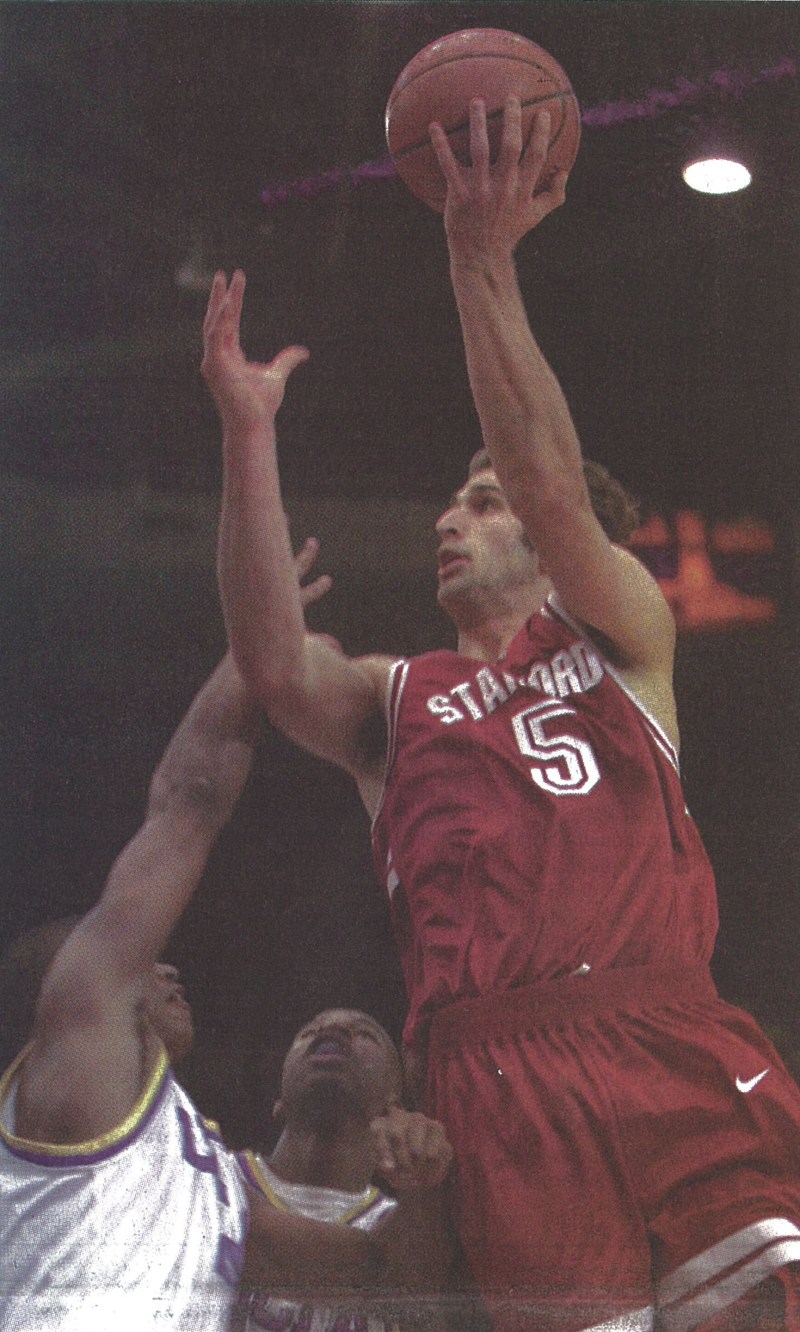“Two Arizona fans stood outside the McKale center,” began an article in the Feb. 26, 1999, issue of The Stanford Daily, “smoking their cigarettes during halftime of last month’s Cardinal-Wildcat basketball game.
“‘I just can’t stand Stanford,’ one exclaimed to a friend. ‘And I can’t stand Peter Sauer. Sauer’s an asshole.’
“When asked how he came to his colorful conclusion, a strange look — a mix that showed he was both angered that such an inquiry was made and confused at trying to find the answer — crossed his face.
“‘What do you mean? He just is! Look at him!’”
***
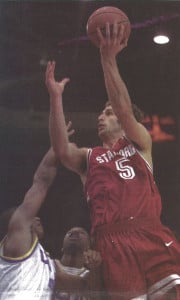
Peter Sauer ’99, 35, died on Sunday night when he collapsed due to an enlarged heart and hit his head on a concrete basketball court, fracturing his skull. A former Bank of America executive with a wife and three kids, Sauer led squads that featured some of Stanford’s best scorers of all time: Brevin Knight, Arthur Lee, Kris Weems and Mark Madsen.
Called “quietly aggressive,” “smothering” and “a pest” in that 1999 Daily article, Sauer managed to get under opposing crowds’ skin with his apparently laid-back demeanor and solid all-around play. Even his hair, straight off the head of Kramer from “Seinfeld,” was a source of annoyance.
“The student body really liked him though, because he was so scrappy, because he would get on other teams’ nerves,” recalls Jim Tankersley ’00, a former men’s basketball columnist for The Daily and its Volume 215 editor in chief. “The Sixth-Man Club loved guys who got on other teams’ nerves, and absolutely, Sauer.”
Sauer was never a top-three scorer, but he was a key part of teams that made four NCAA tournament appearances, reached the Final Four in 1998 and won the Cardinal’s first ever Pac-10 title its final season.
“The way his friends described him as a person,” Tankersley said, “was very similar to what his game was like: fundamentally unselfish.”
Both a small and power forward for the Cardinal, Sauer started 96 times over his final three seasons, including in each of his last 95 collegiate games, captaining the team in his junior and senior seasons.
“He was the heart and soul of our program in terms of leadership and mentoring other players,” said Madsen, a three-year teammate of Sauer’s, after his death. “Pete was so well-loved. He was a leader among men and you know he cared about you.”
***
Sauer’s career truly began at the end of his freshman year, during the 1996 NCAA tournament. As Stanford lost a 79-74 heartbreaker against top-ranked Massachusetts, a clutch performer was born.
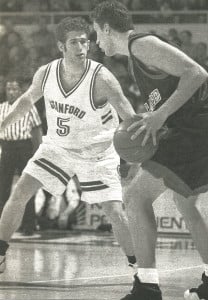
Down by three points late in the game, Stanford needed a big perimeter shot to keep its season alive. Things went Sauer.
“Head coach Mike Montgomery knew that his sharpshooter would not get a clean look,” reads the April 1, 1996, edition of The Daily. “So the play went to the second option, freshman Peter Sauer fading back on the left wing to the three-point line.
‘We’d been running that play a lot down the stretch for 10-15 footers, but we needed the three,’ Sauer said. ‘That made it a lot harder — a fade-away 20-footer.’
Sauer got a clean look at the basket but shot off-balance. The trajectory of the shot reflected its hurried nature, as the ball ricocheted hard off the glass and rim.”
“I remember thinking at the time, ‘Wow, a classmate of mine is taking this big shot — really?’” remembers Ed Guzman ’99, a Stanford freshman that year who is now the sports copy chief at The Washington Post. “He just kind of shook it off and kept going.”
Instead of crushing the young freshman, Sauer’s trial-by-fire reinforced a work ethic that would pay dividends several times over the next three years.
“‘The veterans all acknowledged that I played hard, and that’s how we look at it in our program,’ Sauer said. ‘If you play hard off the bench, you’ll get no words from the coach for not having shots fall.’”
His days coming off the bench were short-lived, and the next time Stanford’s postseason fate rested on Sauer, he wouldn’t miss.
***
Sauer quickly established himself as the 1997 Cardinal’s starting power forward, and the sophomore was a quiet spark plug in Pac-10 play; a week after Stanford had been swept by in-state rivals Cal, USC and UCLA, Sauer helped keep the Cardinal in the hunt for the conference title with a double-double against Oregon.
Still a perfect 10-0 at home but on the bubble for the NCAA tournament, the Cardinal trailed a favored Arizona team at halftime of a must-win game. In a packed house of 7,391 at Maples Pavilion, Tankersley, a freshman at the time, took in the action from an overflow student section behind one of the baskets.
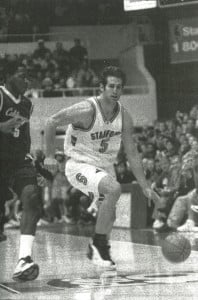
“That Arizona team was really good,” he recalled of the No. 12 Wildcats. “They were better than us. They were more athletic, they made more shots, but Brevin — he was Brevin, and he got up for big games.
“I remember it being very back-and-forth, and being like no sporting event I had ever attended. I mean, just the tension was enormous. Every possession, from about midway through the second half, it felt like the game depended on it, which is pretty amazing for a regular-season game.”
With Stanford down by two points in the final moments, it was time for Sauer’s redemption.
“It’s not often that a college basketball player gets a chance to play hero by making the last-minute shot in a big game,” began The Daily’s March 7, 1997, recap. “For Stanford sophomore Peter Sauer, it’s already happened twice.”
“The last play, you could feel it, everyone in the building expected Brevin to take that shot — everyone,” Tankersley remembered. “And he drove, and they collapsed on him…he did the exact right thing for a point guard.
“He found Sauer, and Sauer was wide freaking open. We knew, as soon as he caught the ball, not even when he shot but as soon as he caught it, that it was going in.”
“Last night, Sauer got a second chance,” the story continued, “and this time the 6-foot-7 forward delivered.
“‘I’ve been thinking about that ever since that happened,’ Sauer said of his missed shot against UMasss. ‘So it’s nice to get one in.’
“Sauer’s shot was merely the finishing touch to one of the most thrilling games in Maples Pavilion history.”
“I remember being on the court bouncing up and down,” Tankersley said, “and feeling like I had never jumped higher in my life, because everybody’s going and the floor was really, really springy. The players were just elated and bouncing around, and it was the first time you really thought, ‘You know, these guys could have a run in them.’”
***
The Cardinal made it to the Sweet Sixteen that year behind two late Sauer jumpers in a 72-66 win over Wake Forest, but its tournament ended in overtime against Utah.
“Probably the Sweet Sixteen wouldn’t have happened without that Sauer shot,” Guzman said of the Arizona game. “That seems hyperbolic, but I really believe that, because that was a huge stepping stone to what they would go on and become.
“The Final Four run wouldn’t have happened [either],” he added.
But even the Final Four run would have its roots in a disappointing, second-place conference finish. Sauer, ever in the background, was one of the Cardinal’s most reliable options as a junior.
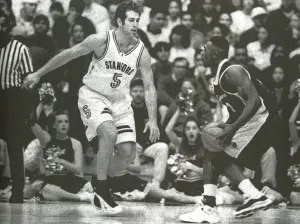
That year, Stanford was unexpectedly riding a school-record 18-game winning streak without the graduated Knight when Arizona rolled back into Maples Pavilion for a huge, top-10 tilt. Sauer’s 23 points against the Wildcats were a career best, but the undefeated Cardinal let things slip away in the second half and was embarrassed at home, 93-75.
Overshadowed by Lee and Madsen, Sauer’s performance wasn’t even mentioned in The Daily’s recap of that game until its second-to-last paragraph. (Tankersley and Guzman were the two sports editors that night.)
“It almost feels like a relic of college basketball right now, because you don’t think of a lot of teams that are like this today, but what made those teams work well was that they had some really well-defined role players,” Tankersley said. “Sauer was just there leading the team, giving them energy, doing all the little things. Everybody had these great roles and as a captain, he sort of was the orchestrator of a lot of those roles.”
His absence from the limelight was explored later that year in a feature by Cardinal Today, a game-day program published by The Daily.
“If you remember him only as the man who sank the game-winning shot against Arizona last season, you’ve missed quite a bit,” opened the article.
“Junior forward Peter Sauer’s contributions to Stanford’s success [are] substantial, but his actual value to the team may escape the notice of the average fan.
“‘He’s very vocal — he’s a leader,’ said junior guard Arthur Lee. ‘If he sees someone on the team that needs encouragement, he’ll go up to the guy and give him all the encouragement he needs.’”
Guzman, The Daily’s head sports managing editor at the time, happened to be rooming with senior center Tim Young in Roble Hall that year.
“Tim really kind of deferred to Pete Sauer,” Guzman said. “[Sauer would] always come to our room and was checking in on Tim and seeing how he was doing. To me, that spoke volumes about his leadership abilities, that even guys who were slightly older than him were willing to turn to him and look to him to set that tone for the team as a whole.”
Sauer’s on-the-court intensity translated into his best collegiate season, as he went on to average 9.2 points and 4.6 rebounds per game as a junior. But despite the Cardinal’s 15-3 finish in Pac-10 play, 17-1 Arizona grabbed the crown and extended Stanford’s conference-title drought to 35 seasons.
***
Despite the Pac-10 disappointment, the Cardinal still earned a three-seed in the 1998 tournament and was poised for one of the best postseason runs in school history.
“Along the way [through the NCAA tournament],” the March 11 Cardinal Today story concluded, “the Card can expect some close games, and some wonder who will have the ball if Stanford needs the bucket in crunch time.
“‘I definitely feel comfortable in that situation,’ Sauer said. ‘I’m willing and ready to take that shot.’
It’s not like he hasn’t done it before.”
***
Sauer only played for about a half in each of the team’s five tournament games. In St. Louis — where Sauer’s dad Mark worked as an executive with the Blues hockey organization — he watched from the bench as Stanford grabbed an emotional Elite Eight win over Rhode Island thanks to a late-game slam dunk, and-one, by Madsen, clinching the Cardinal’s only Final Four berth since its 1942 national title.
Sauer injured his knee the next week in practice, just four days before the looming semifinal against Kentucky, forcing him to join the team in San Antonio late. After an MRI and a fitting for a brace, Sauer still made the start.
Down four in overtime, Sauer sunk a long three-pointer with 9.2 seconds left to cut Stanford’s deficit to one, 86-85. The Cardinal was forced to foul and the Wildcats’ Wayne Turner missed both shots.
Sauer grabbed the rebound, but with just two seconds to work with he could only launch a long heave at the buzzer. It went wide right.
“Just give us five more seconds,” he said after the game. “That’s all I was asking for.”
“He really kind of brought an air of optimism to the team and to the school,” Guzman said. “The point he was trying to make was, you know, we more or less left it all on the floor there, and yeah, it hurts, but we’ll be alright.
“I’ll always remember seeing this picture in Stanford Magazine not too long after the Final Four run,” Guzman recalled. “Sauer had his arms around Art Lee, I think, as they’re walking off the floor after what to me was just an agonizing one-point overtime loss. But he’s smiling. And it was like, ‘Wow, that just shows you the difference between him and most of the rest of us who are just fans.’”
***
Undeterred, the Cardinal set its sights back on the Pac-10 title for the 1998-99 season, Sauer’s second as a small forward.
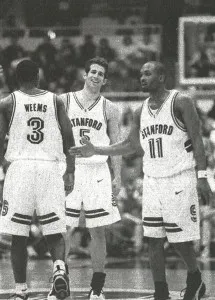
Though he would reach double figures 14 times as a senior, Sauer continued to embrace his standing as a role player on a team stacked with offensive talent. On Jan. 12, The Daily named Sauer one of its two “Athletes of the Week” after a 71-62 win over Cal — and not just because of his 13 points in that game.
“More importantly,” the graphic read, “his solid defense and all-around hustle kept the Cardinal in the game when the starting guards struggled from the perimeter in the first half.”
That was the role Sauer carved out for himself, always hustling, playing for the team and not for himself. “Fundamentally unselfish.”
Following a series of victories that year, the Cardinal faced the fearsome Wildcats at Maples Pavilion on Feb. 28, another chapter in that heated rivalry. The Cardinal was just a win away from clinching its first outright conference championship in 57 years.
“It was probably the one time in my life I scalped tickets,” Guzman said. “Coming off that Final Four year, tickets were impossible. It was the hot ticket.
“The thing that I remember for that game was just how loud it got for all the pregame stuff, for all the ovations,” he added. “They were just drowning out the PA announcer…My ears were ringing for quite a while after that game.”
No. 6 Stanford grabbed a 20-point lead in the first half and never looked back, dominating its No. 7 foes 98-83.
“All four of the original members of the Stanford basketball Class of 1999 stood heroically on the Maples hardwood,” reported The Daily on March 1, “and watched the scoreboard clock tick to zeroes for the last time.
“Sauer was the first to jump on top of the scorers table, an island in the seas of humanity that spilled onto the floor.”
***
Sauer’s Stanford career, like his life, would come to an end far too early.
The second-seeded Cardinal eased by Alcorn State in the first round of the tournament but was upset by 10th-seeded Gonzaga, which never trailed after erasing Stanford’s early 1-0 lead.
Though “the Cardinal climbed to within four points at the half on a phenomenal basket by Peter Sauer as time expired,” as the March 29 recap in The Daily read, it was simply not meant to be for Stanford that year.
“Peter Sauer formed a huddle at half court with Lee and Weems. He didn’t want to let go just yet. There was time for one last memory — albeit a painful one.
“‘I really can’t believe this is all over now,’ Sauer said in the locker room after the game. ‘What makes this all so fun is the relationships with these guys.’
“‘The good times on the road trips, the chemistry we had off the court and all the times we hung out…that is what I will always remember. It seems impossible that I just took that jersey off for the last time.’”
